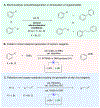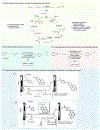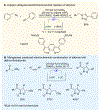Advances on the Merger of Electrochemistry and Transition Metal Catalysis for Organic Synthesis
- PMID: 34797053
- PMCID: PMC9714963
- DOI: 10.1021/acs.chemrev.1c00614
Advances on the Merger of Electrochemistry and Transition Metal Catalysis for Organic Synthesis
Abstract
Synthetic organic electrosynthesis has grown in the past few decades by achieving many valuable transformations for synthetic chemists. Although electrocatalysis has been popular for improving selectivity and efficiency in a wide variety of energy-related applications, in the last two decades, there has been much interest in electrocatalysis to develop conceptually novel transformations, selective functionalization, and sustainable reactions. This review discusses recent advances in the combination of electrochemistry and homogeneous transition-metal catalysis for organic synthesis. The enabling transformations, synthetic applications, and mechanistic studies are presented alongside advantages as well as future directions to address the challenges of metal-catalyzed electrosynthesis.
Conflict of interest statement
The authors declare no competing financial interest.
Figures






























References
-
- Moeller KD Using physical organic chemistry to shape the course of electrochemical reactions. Chem. Rev 2018, 118, 4817–4833. - PubMed
-
- Moeller KD Intramolecular Carbon–Carbon Bond Forming Reactions at the Anode. In Electrochemistry VI Electroorganic Synthesis: Bond Formation at Anode and Cathode; Steckhan E, Ed.; Springer: Berlin, Heidelberg, 1997; pp 49–86.
-
- Francke R; Little RD Redox catalysis in organic electrosynthesis: basic principles and recent developments. Chem. Soc. Rev 2014, 43, 2492–2521. - PubMed
-
- Shono T; Hamaguchi H; Matsumura Y Electroorganic chemistry. XX. Anodic oxidation of carbamates. J. Am. Chem. Soc 1975, 97, 4264–4268.
Publication types
MeSH terms
Substances
Grants and funding
LinkOut - more resources
Full Text Sources
